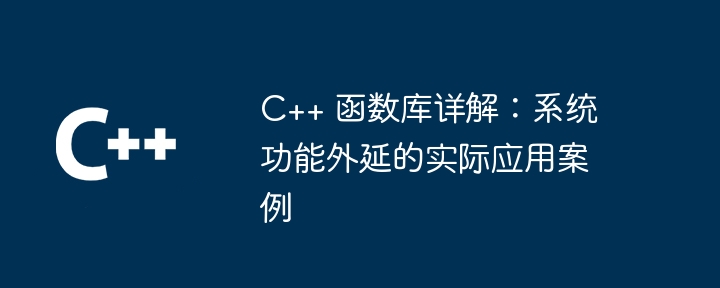Home >Backend Development >C++ >Detailed explanation of C++ function library: practical application cases of system function extension
Detailed explanation of C++ function library: practical application cases of system function extension
- WBOYWBOYWBOYWBOYWBOYWBOYWBOYWBOYWBOYWBOYWBOYWBOYWBOriginal
- 2024-04-30 11:06:02693browse
C++ 函数库通过预定义函数集合扩展了程序功能,提供了系统功能支持,包括容器、算法、流和诊断。开发人员可创建自定义函数,例如自定义排序函数,以实现特定需求,如按成绩降序排序。该函数库还支持并发编程、网络通信和文件操作,提升编码效率和软件健壮性。

C++ 函数库详解:系统功能外延的实际应用案例
在软件开发中,函数库扮演着至关重要的角色。它们提供了预定义的函数集合,可极大地简化开发过程并扩展程序功能。C++ 标准库就是其中一个强大的函数库,它为各种系统功能和实用程序提供了广泛的支持。
C++ 函数库概述
C++ 标准库包含以下几个主要组件:
- 容器(Containers):如 vector 和 map,用于存储和操作数据。
- 算法(Algorithms):如 sort 和 count,用于对数据执行各种操作。
- 流(Streams):如 cout 和 cin,用于输入和输出。
- 诊断(Diagnostics):如 assert 和 error,用于调试和处理异常。
利用 C++ 函数库外延系统功能
C++ 函数库不仅提供了基本功能,还允许开发人员通过创建自定义函数来扩展程序功能。这种灵活性使得 C++ 成为开发复杂应用程序的理想选择。
实战案例:自定义排序算法
考虑一个存储学生姓名和成绩的 vector。我们希望按照成绩降序对 vector 进行排序。
#include <vector>
#include <algorithm>
// 定义一个自定义排序函数
bool compareStudents(const std::pair<std::string, int>& a, const std::pair<std::string, int>& b) {
return a.second > b.second;
}
int main() {
// 创建一个学生成绩 vector
std::vector<std::pair<std::string, int>> students {
{"Alice", 90},
{"Bob", 85},
{"Carol", 95},
{"Dave", 80}
};
// 使用自定义排序函数对 vector 排序
std::sort(students.begin(), students.end(), compareStudents);
// 打印排序后的成绩
for (auto& student : students) {
std::cout << student.first << ": " << student.second << std::endl;
}
return 0;
}此代码定义了一个自定义排序函数 compareStudents,它将两个学生对进行比较并返回较高成绩的学生。然后,此函数作为第三个参数传递给 std::sort,以对 vector 进行排序。
其他应用场景
C++ 函数库还有许多其他应用场景,包括:
- 创建线程以并发执行任务。
- 使用网络库进行网络通信。
- 利用文件系统库操作文件。
结论
通过利用 C++ 函数库,开发人员可以轻松扩展程序功能并解决复杂的编程问题。通过学习和应用函数库,可以显著提升编码效率并打造更健壮的软件。
The above is the detailed content of Detailed explanation of C++ function library: practical application cases of system function extension. For more information, please follow other related articles on the PHP Chinese website!

